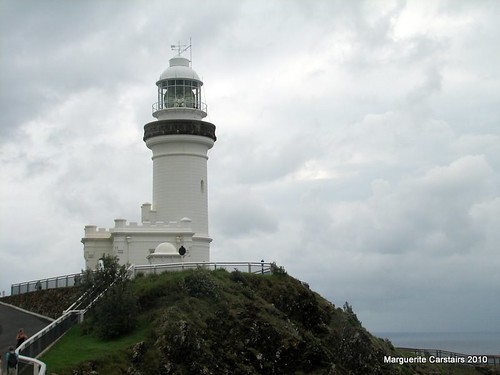Byron Bay Lighthouse
Standing on a bald rocky headland with a precipitious cliff on the east side, and a sheer drop of approximately 100 metres, Cape Byron Lighthouse is the most easterly light in Australia, and one of the most powerful.
Built in the style used by NSW colonial architect, James Barnet, Charles Harding his successor, prepared the plans for the Cape Byron Lighthouse. Due to the elevation of the site, a tall structure was not required. Construction began in 1899 with the levelling of the site by contractors, Mitchell and King. The total cost was £10,042 (pounds) to the contractors, £8,000 for the apparatus and lantern house, and £2,600 for the road from Byron Bay township.
Tower Construction
The tower is constructed from concrete blocks made on the ground, lifted and cemented into position and finally cement rendered inside and out. This technique saved erecting framework.
The Lens
The eight ton optical lens was made by the French company, Societe des Establishment, Henry Lepante, Paris. It is a dioptric first-order bivalve double flashing lens and contains 760 pieces of highly polished prismatic glass. The lens revolves on a bath of 7cwt mercury. The original illuminant was a concentric six-wick kerosene burner. This was replaced in 1922 by a vaporised kerosene mantle burner, which increased the intensity from 145,000 cp to 500,000 cp. In 1956, the light was converted to mains electricity increasing the intensity to 2,200,000 cd.
The original lens weight driven mechanism, which works on a similar principle as that of a grandfather clock, was also replaced with an electric drive motor when the light was converted to electric operation. An auxiliary fixed red light is exhibited from the tower to cover Julian Rocks to the north.
The Event
The installation of the lighthouse was regarded as a great event in the district of Byron Bay. A banquet was arranged and special trains carried visitors from Lismore and Murwillumbah for the opening. The Premier of the day, the Hon. John See (later Sir John See), was accompanied by a number of his colleagues who left Sydney in the Government steamer 'Victoria'. However, bad weather prevented the vessel from arriving on time, and when the party should have been banqueting the steamer was some thirty miles away. She arrived in the bay just before midnight on 30 November 1901, but again, the weather made it impossible for the party to land until dawn.
The Lighthouse Opened
After landing, the party was informed that the banquet had taken place on the previous evening, and the necessary toast had been heartily drunk in the absence of the Premier and his party. Mr See, after making an acrobatic performance in landing, was cordially cheered, and later formally welcomed at the Great Northern Hotel. Interestingly, the lighthouse was christened with a rich and sumptuous vintage burgundy - not dashed against the tower to waste, but sipped by the ladies and legislators to compensate for having missed all the good things of the banquet held the night before.
Visit our Cape Byron Headland Reserve page for more information on the Cape.
Courtesy Cape Byron Trust
Photographs and Art from Places on the Coast of East Australia. Gold Coast, Stradbroke Island, Burrum Heads, Hervey Bay and surrounding coastal areas
Friday, January 7, 2011
Lighthouse at Byron Bay
Subscribe to:
Post Comments (Atom)

140x45.jpg)




No comments:
Post a Comment